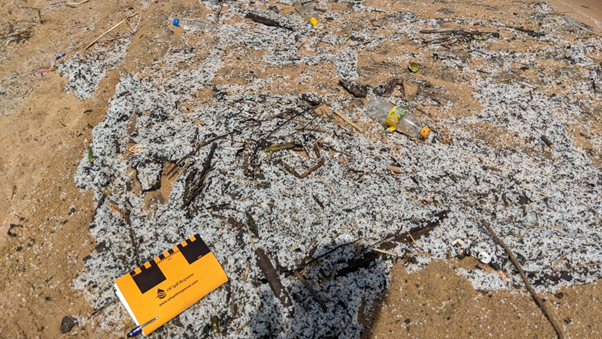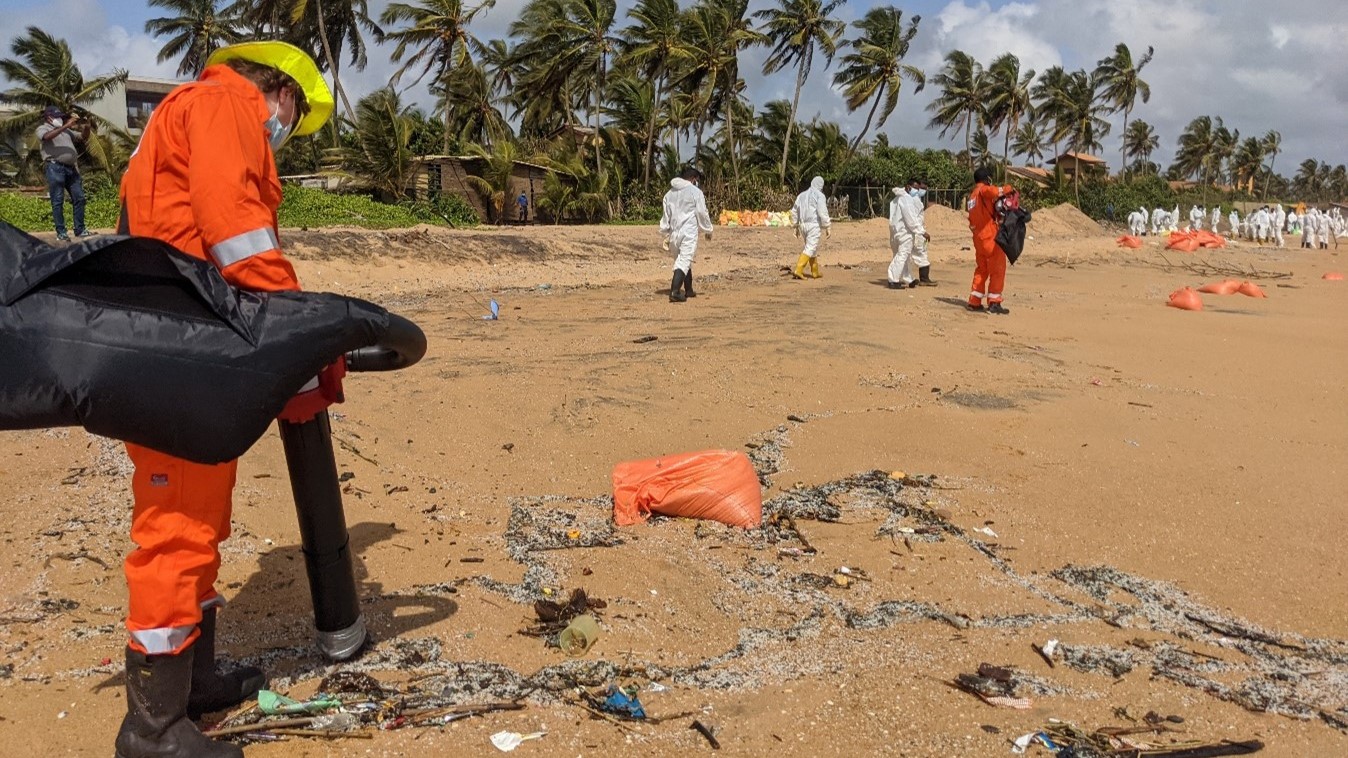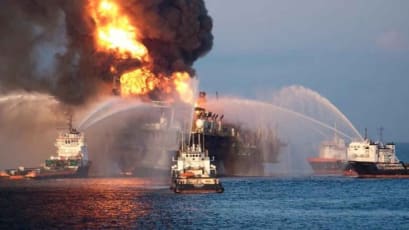X-Press Pearl: navigating a major incident with multiple contaminants
Loaded with nearly 1,500 containers, the X-Press Pearl caught fire off the coast of Colombo, Sri Lanka. What initially looked like a standard oil spill would lead to a different type of contamination in the ocean.
Background
The X-Press Pearl, a container ship carrying nearly 1,500 containers, caught fire on its voyage from Hazira, India, to Colombo, Sri Lanka, in May 2021. The vessel was anchored approximately 10 km off the coast of Colombo when the fire broke out, burning for two weeks and reaching temperatures of at least 1,500 degrees Celsius. This intense heat consumed all hydrocarbons on board, but the incident resulted in the release of hazardous cargo, including nitric acid and plastic nurdles (small plastic pellets), into the marine environment. The nurdles, which are raw materials for plastic production, posed a significant pollution threat, contaminating coastal areas and impacting marine ecosystems on an unprecedented scale.
Response activation
The initial response to the X-Press Pearl fire involved multiple agencies, including the Sri Lankan Navy, Marine Environment Protection Authority (MEPA), and local disaster management units. These organisations worked to extinguish the fire and assess immediate risks, such as potential oil leaks and hazardous cargo release. The International Tanker Owners Pollution Federation (ITOPF) and vessel insurers also became involved early on to evaluate environmental and financial impacts.
The context behind OSRL’s involvement
OSRL was activated within days following these initial assessments when the scale of environmental contamination became evident. The activation was prompted by the need for a coordinated, technical response to the widespread environmental impact caused by the nurdle spill. The vessel’s insurers and local authorities turned to OSRL, recognising its expertise and proven capabilities in responding to unconventional marine pollution incidents.. The activation process began with a detailed consultation between OSRL’s technical advisors, ITOPF, and Sri Lankan authorities to define the scope of work and operational priorities.

Main goals and priorities
- Perform extensive SCAT (Shoreline Cleanup Assessment Technique) surveys to identify contamination hotspots.
- Implement site-specific cleanup techniques tailored to nurdle recovery.
- Provide training and capacity-building sessions for local responders.
- Develop a comprehensive waste management plan for collected nurdles and other debris.
Unique challenges
- Pollutant complexity: Unlike oil, nurdles do not dissolve or evaporate, requiring mechanical recovery and separation techniques. This required us to adapt our oil spill response strategies to this particular type of pollutant. It was the first time OSRL was involved in a nurdle spill incident.
- Wide dispersal: Currents and wave action spread nurdles over a vast area, complicating containment and recovery efforts.
- Multi-stakeholder coordination: Gaining buy-in from the Sri Lankan authorities, ITOPF, the United Nations, CEDRE and other foreign government representatives in regards to our cleanup strategies. Ensuring alignment among numerous organisations was crucial.
- Environmental sensitivity: Protecting critical habitats such as coral reefs, seagrass beds, and mangroves while conducting cleanup operations.
- COVID pandemic: travel restrictions added complexity to mobilisation of technical advisors and equipment.

Nurdles on Poruthota beach
Response methodology
- Assessment and mapping: Utilised drone surveillance and GIS-based mapping tools to monitor nurdle spread and assess shoreline contamination. ArcGIS technology allowed real-time updates for strategic decision-making.
- Cleanup techniques:
- Mechanical recovery: Developed and deployed sieves, trommels, and custom-built vacuum systems to recover nurdles from sand and debris.
- Shoreline techniques: Employed manual collection in mangroves and other sensitive areas, supported by biodegradable barriers to prevent further spread.
- Innovative solutions: Piloted water separation tanks and flotation techniques to separate nurdles from organic debris.
- Stakeholder collaboration: Conducted regular strategy meetings with ITOPF, UN agencies, and Sri Lankan authorities to ensure harmonised operations.
- Training and capacity building: Delivered hands-on training to over 200 local responders, enhancing their technical skills in dealing with nurdle contamination.
- Waste management: Partnered with waste treatment facilities to ensure environmentally responsible disposal of collected nurdles and associated

Trenches being dug on Sarakkuwa beach

Testing blower vacuum clean-up methods
Results
- Environmental impact mitigation: Recovered over 1,000 metric tonnes of nurdles and debris from affected shorelines.
- Capacity building: Strengthened local response capabilities through targeted training and equipment donations.
- Institutional frameworks: As part of a multi-year initiative, we contributed to the formulation of a Maritime Disaster Plan that incorporates non-oil pollutant scenarios and focuses on building local capabilities.
- Innovation legacy: Documented response methodologies for global dissemination, creating a reference for future incidents involving plastic pollution. Alongside Oracle Environmental, ITOPF, and IMO, we have created the Plastic Pollution Working Group to help expand and improve knowledge related to plastic pollution.
Incident timeline
- 20 May 2021: The X-Press Pearl reports a nitric acid leak. Crew attempts to neutralise it but struggles due to limited resources.
- 21 May 2021: The ship anchors approximately 10 km offshore while awaiting port clearance. Early signs of fire are detected in the cargo area.
- 25 May 2021: A fire breaks out on the vessel, quickly spreading across multiple containers. The Sri Lankan Navy and MEPA initiate firefighting efforts.
- 26 -28 May 2021: Firefighting efforts intensify. Nitric acid and other hazardous materials spill into the ocean, alongside significant volumes of plastic nurdles.
- 31 May 2021: OSRL is activated. Initial OSRL team arrives to assess the situation and strategise the response.
- 2 June 2021: The fire is officially declared extinguished. OSRL begins conducting SCAT surveys to map nurdle contamination.
- June 3 – July 2021: OSRL implements targeted shoreline cleanup operations with support from local agencies.
- August 2021: OSRL concludes its primary response operations, having recovered over 1,000 metric tonnes of nurdles and debris. Long-term monitoring and recovery plans are handed over to local authorities.
Key learnings
- Adaptability is essential: The need to modify oil spill response knowledge and techniques for nurdles highlights the importance of considering a diversity of pollutants when responding, particularly in the shipping industry.
- Stakeholder engagement: Effective coordination across diverse organisations is critical for operational success. Building relationships with governing authorities will make all the difference in an emergency.
- Preparedness matters: Regular training and scenario planning for non-traditional pollutants can enhance response readiness. Operators should strive to achieve a base level of self-sufficiency so that they can confidently act when the first signs of an emergency appear.
- Data utilisation: Real-time data collection technology tools allow the monitoring and prediction of spill movements, making them invaluable for decision-making in complex spill responses.
Why choose OSRL
With decades of experience and a global team of experts, we provide proven solutions tailored to diverse challenges. Our extensive inventory of specialised equipment and resources enables swift and effective responses to spills of all magnitudes. We collaborate with local organisations and regulatory bodies worldwide, ensuring seamless integration and alignment in response operations. By leveraging the latest advancements in spill response, we continuously enhance our methods and capabilities to address evolving environmental and industry needs.
Want to talk about spill response?
OSRL offers a holistic approach to response, with solutions for offshore, inland and subsea incidents. Our teams are trained to operate in all environments—from remote regions to extreme cold—and bring specialised capability to all aspects of spill response, including areas like oiled wildlife that require specific expertise. Our Members get access to technical advisors, our Global Dispersant Stockpile, aviation services, and equipment hire solutions.
Find out more about our Membership options.





